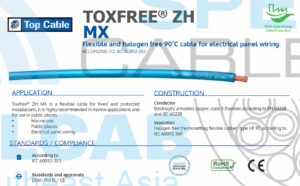SPECIAL CABLES
Electric cables for special applications.
TOPFLAT H05VVH6-F & H07VVH6-F
Flat cables for lifts, cranes, hoists and conveyor systems.
TOPFLAT H05VVH6-F and H07VVH6-F is a flat cable specially designed for cranes, lifts, hoists, drum reeling and conveyor systems. The hanging length of the cable can reach up to 35m and its pull out speed can reach up to 1.6 m/s (overlaying cables is not recommended when installing).
TOXFREE ZH ALARMS Z1OZ1-K (AS)
Cable for alarm systems
TOXFREE ZH ALARMS Z1OZ1-K (AS) cable is designed to comply with the regulations of Fire Detection and Alarm systems. It is recommended to be used in public places. It should not be used for direct connection to the power supply network or other low impedance sources.
X-PUR H07BQ-F
Flexible cable for mobile service
The cable X-PUR® H07BQ-F is a flexible cable for mobile service. Suitable for installations where the cable must withstand medium mechanical stress, for machines in industrial and agricultural workshops, for motors and transportable machines on construction sites, for wind turbines and for agricultural exploitations.
COAXIAL SATELLITE 17 VATC
Coaxial cable for television signals
Coaxial cable for the reception and distribution of digital terrestrial, analogue and digital satellite television signals. These cables do not have a rated voltage and cannot be used in electric power transmission circuits.
COAXIAL SATELLITE 21 VATC
Coaxial cable for the reception and distribution of digital terrestrial, analogue and digital satellite television signals.
Coaxial cable for the reception and distribution of digital terrestrial, analogue and digital satellite television signals with enhanced screen.
- Digital terrestrial television.
- Analogical satellite.
- Digital.
PARALLEL AUDIO CABLE
Cable for connecting music equipment speakers
Cable specially indicated in domestic installations for connecting music equipment speakers and for broadcasting music signals throughout the home.
Top Cable, a global supplier to the world’s special cables.
At Top Cable we have a wide range of special cables designed and produced by our team of experts. Special cables are cables with specific properties, structures or uses. They are optimal for installation in environments requiring special characteristics, such as extreme temperatures or resistance to factors such as corrosion, fire or explosion.
FREQUENTLY ASKED QUESTIONS (FAQ) ON SPECIAL CABLES
What are the different types of LV cables?
There are different types of special low-voltage cables. Among the Top Cable range you can find cables for audio-visual use, for mobile service, alarm systems and for lifts, cranes, hoists or transport systems.
What is the best low voltage wire?
The choice of the best cable depends on the characteristics of each project. The suitability of the cable will be determined by the correct choice according to the needs of the installation.
What is the difference between HV and LV cables?
Low voltage cables operate at voltages up to 1 kV (1,000 volts) and are used for residential, commercial and light industrial applications. High-voltage cables, on the other hand, are designed for voltages above 1 kV, typically ranging from 1 kV to 765 kV or higher, and are used to transmit electricity over long distances and in high-demand industrial applications.
How are low voltage special cables different from standard LV cables?
While standard LV cables are suitable for general use, low voltage special cables are tailored for specific needs and environments, offering enhanced performance and protection.
How to choose the right low voltage special cable?
Choosing the right special cable for your application involves several important considerations. Determine the voltage level required for your application, considering factors like the length of the cable run and the ambient temperature, as these can affect the cable’s performance, choose the appropriate insulation material based and the best conductor material. Beyond that, it is necessary to assess the specific performance required by the installation.
Dây cáp điện đơn TOP CABLE 0.6/1KV TOXFREE ZH MX 90ºC Halogen Free | Chính Hãng – MARINE CABLES – Offshore – Giá Tốt Nhất
Dây cáp điện đơn TOP CABLE 0.6/1KV TOXFREE ZH MX 90ºC Halogen Free | Chính...

